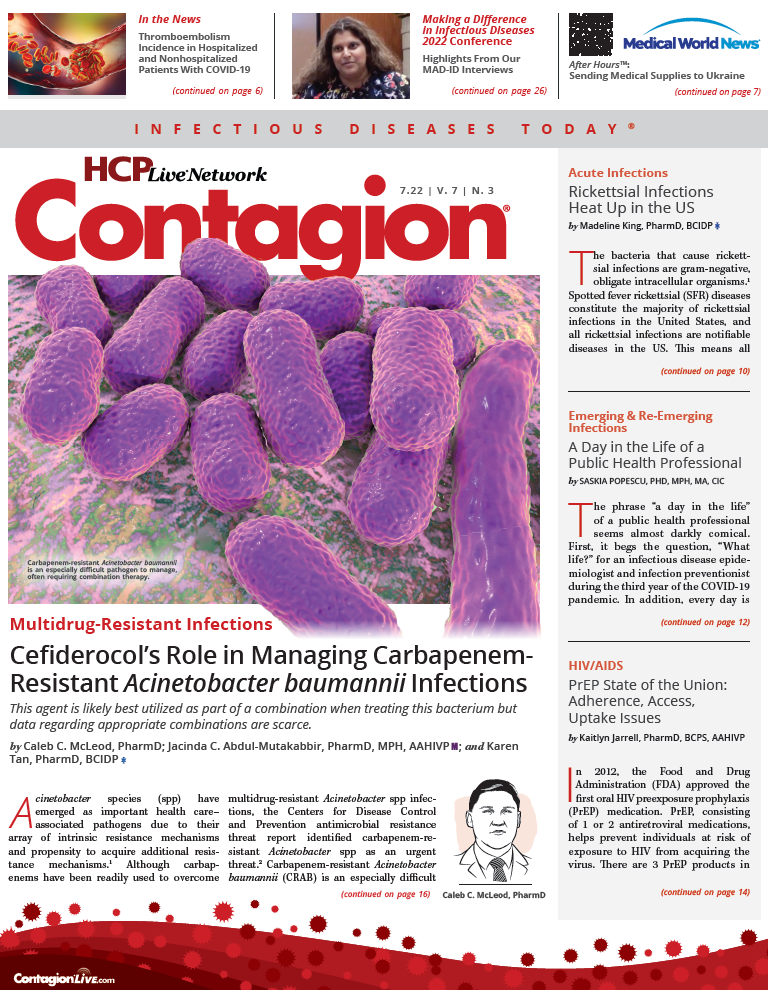COVID-19 Vaccine Boosters: Benefits, Expansion of Eligibility, and Mixing and Matching of Vaccines
Clinicians offer insights on a variety of elements surrounding boosters.

COVID-19 vaccine boosters are beneficial for reducing risk for transmission, hospitalization, and severe disease, particularly among older individuals and frontline workers, but increasing uptake of COVID-19 vaccines among vaccine-hesitant individuals and those without access to the vaccines should remain a priority moving forward, according to infectious disease experts who participated in a recent Contagion® Peer Exchange.
The program was moderated by Peter Salgo, MD, professor of medicine and anesthesiology at Columbia University Vagelos College of Physicians and Surgeons in New York, New York. The panelists also discussed the background behind the misinformation related to the rapid development of the COVID-19 vaccines and recent data on the safety and efficacy of mixing and matching of different vaccines.
EXPANSION OF COVID-19 BOOSTER SHOT USAGE
With the high level of immune-evasive mutations in the Omicron variant of SARS-CoV-2, increasing titers of neutralizing antibodies with a COVID-19 booster is likely justified, said Angela Rasmussen, PhD, a research scientist at the Vaccine and Infectious Disease Organization in Saskatchewan, Canada. However, she added that the expansion of eligibility for COVID-19 boosters does not address the individuals who are vaccine hesitant or do not have access to vaccines. Donald Alcendor, PhD, added that many of the individuals currently seeking vaccines are those who have already received their first 2 primary doses and that vaccinating individuals who have not received any vaccines (whether it was due to hesitancy or lack of access) should be a priority.
“To avoid the unvaccinated in light of a booster is an overall mistake in judgment going forward,” said Alcendor, an associate professor of microbiology and immunology at Meharry Medical College and adjunct associate professor of pathology, microbiology, and immunology at Vanderbilt University School of Medicine in Nashville, Tennessee. “People who want boosters, they’re already convinced that the vaccine is for them. There’s no [need] to push them toward getting that booster. They sit down and get that booster right away. They think it’s going to work for them, and they’re excited about getting it.”
Alcendor added that the mRNA vaccine platform, first developed 2 decades ago and tested in SARS-CoV-1 and Ebola virus but only recently reaching the public eye in the form of the COVID-19 vaccines, is likely to be groundbreaking for changing the general concepts of vaccines. For example, a combination vaccine with influenza and COVID-19 on the same mRNA cassette is undergoing development.
“Because these vaccines are modular, you can adapt them relatively quickly to variants as well,” Alcendor said. “You can change the mRNA sequence and now you have a targeted vaccine that can deal with a specific variant.”
COVID-19 BOOSTER SHOT ELIGIBILITY
Alcendor noted that there is a prevailing misperception that the mRNA COVID-19 vaccines are new experimental vaccines that have not been adequately tested. Jason Gallagher, PharmD, BCPS, FCCP, FIDP, FIDSA, added that this may be because most of the general public is unaware of research conducted in the years leading up to the pandemic and only know about the seemingly rapid development and approval of the vaccine. Gallagher, who is a professor and clinical specialist, infectious diseases, and director of the PGY2 Residency in Infectious Diseases Pharmacy at the Temple University School of Pharmacy in Philadelphia, Pennsylvania, also noted that demonstrating vaccine efficacy during the COVID-19 pandemic could have been done relatively quickly because infection rates were high.
“To get [the COVID-19 vaccine] from clinical trials to authorization in a fairly short time is incredible,” Gallagher said. “They didn’t see all the development that went on over those years. The only part people have seen is that last part: disease detected, being described, and then a vaccine developed in the space of roughly a year by the time it got to people.”
The populations with the strongest need for a COVID-19 booster are older individuals, particularly they have a less robust immune response to the vaccine, said Jeff Goad, PharmD, MPH, associate dean of academic affairs, professor, and chair of the Department of Pharmacy Practice at Chapman University School of Pharmacy in Irvine, California. Individuals who received their original series of vaccines early also should receive a booster to reduce risks for transmission, hospitalization, and severe disease. Alcendor and Goad added that frontline workers, including those who work in health care or daycare centers, teachers, firefighters, and police officers, should be prioritized for boosters because their public presence makes them a key link in the transmission chain.
MIXING AND MATCHING COVID-19 VACCINES
Gallagher said that heterologous boosters (different from the primary vaccine) were shown to be safe and immunogenic in the phase 1/2 MixNMatch study (NCT04889209) funded by the National Institute of Allergy and Infectious Diseases.1 Results of the study, which included healthy adults who received a full COVID-19 vaccine regimen available under emergency use authorization, showed that neutralizing antibody titers increased with heterologous boosters as well as homologous boosters (same as the primary vaccine), and spike protein– specific T-cell responses increased with all combinations except for the homologous Ad26.COV2.S ( Johnson & Johnson-Janssen) group.1
Rasmussen added that heterologous vaccination has been done in several European countries and Canada because of supply issues and that the National Advisory Committee on Immunization (Canada’s immunization advisory board) stated that heterologous vaccination is ideal because individuals who received an adenovirus vector vaccine as the initial dose followed by an mRNA vaccine tended to have higher antibody responses. However, whether this higher antibody response translates to increased protection against the effects of COVID-19 remains to be seen, Rasmussen said.
“We’ve been doing heterologous vaccinations for a long time for many other vaccine platforms. In general, it’s not something that is a huge mystery,” she said. “I think it’s only a mystery to people now because they are paying more and more attention to different types of vaccines. Before this pandemic, I certainly wouldn’t think of anybody coming in and saying, ‘I got whatever the flu vaccine I got is and you got something else. I got recombinant, you got egg based.’ I’ve never heard of people doing that. I think that’s just because people probably haven’t put a lot of thought into vaccine brand names.”
Alcendor added that when the booster shots initially became available, some individuals chose the Moderna vaccine because it appeared to have better efficacy when it was mixed and matched with other vaccines. However, Gallagher noted that the dose of the Moderna vaccine used in the MixNMatch trial (100 μg) was higher than the dose used in the Moderna booster available to the public (50 μg), whereas the doses of the Pfizer and J&J vaccines used in the study were the same as those given to adults (30 μg and 5 × 1010 virus particles, respectively). Gallagher and Salgo both noted that keeping track of the dose received at each booster is particularly important with the availability of pediatric vaccines.
“Some people, when they get their children vaccinated, refuse to go and get their booster on the same day,” Salgo said. “They don’t want there to be any question on that table with these syringes about which one is the adult dose and which one is the pediatric dose.”
The pediatric vaccine formulation has been altered slightly to contain a small amount of Tris buffer that acts to improve the shelf life of the vaccine, which will be important when vaccination moves from large centers to pediatricians’ offices, Gallagher said. However, this change in formulation has garnered additional media attention and a misperception of Tris buffer as a potentially injurious agent. Addressing these and future misperceptions remains a continued priority, Alcendor said.
“I had to explain to people that the Tris buffer is there in an amount that wouldn’t affect anybody,” he said. “The Tris buffer is there to improve the shelf life of the vaccine. [The media sources] have misinformation saying that this Tris buffer is there to cause all sorts of injury to children who would receive the childhood vaccine.”

